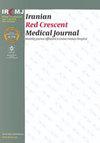Comparison of the Dexmedetomidine and Sufentanil Added to Spinal Anesthesia with Bupivacaine for Hemodynamic Stability and Postoperative Analgesia in Elective Cesarean Section Surgery: A Single-Blinded Randomized Clinical Trial
IF 0.2
4区 医学
Q3 MEDICINE, GENERAL & INTERNAL
引用次数: 0
Abstract
Background: Hemodynamic instability, including hypotension and bradycardia, can occur due to spinal anesthesia by bupivacaine. However, it is possible to reduce the chance of hemodynamic changes by the reduction of the dose of bupivacaine and/or the addition of adjunctive agents. Objective: This study aimed to compare the effects of the addition of intrathecal dexmedetomidine and sufentanil to spinal anesthesia with bupivacaine in elective cesarean section (CS). Methods: This prospective single-blinded randomized clinical trial with parallel groups was performed on 60 pregnant women who were candidates for elective CS in Imam Reza Hospital in Kermanshah, Iran. In addition to receiving 10 mg of hyperbaric bupivacaine 0.5%, they were randomly divided into two groups to receive intrathecal sufentanil 5 μg (30 cases) or dexmedetomidine 5 μg (30 cases). Changes in blood pressure, heart rate, and occurrence of side effects (e.g., nausea, vomiting, headache, and shivering) were recorded within 1 h after the injections. Moreover, the postoperative analgesia rate and duration (using a visual analog scale [VAS]) were recorded within the first 24 h after the completion of the CS. Headache severity (using a VAS) was also measured during the first week after CS. Results: Patients declared their satisfaction with analgesia after surgery. No significant difference was found between the two groups in terms of heart rate and systolic and diastolic blood pressure changes during the first 60 min. Similarly, no significant difference was observed between the two groups in terms of the severity of incision pain in the first 24 h after CS surgery. On days 3, 4, and 5, none of the patients in the sufentanil and bupivacaine group had headaches (VAS=0), but patients in the dexmedetomidine and bupivacaine group had some degree of headache (P=0.040). Conclusions: Based on the results, intrathecal administration of bupivacaine with either sufentanil or dexmedetomidine in CS did not have significantly different effects, except for slightly more severe headaches in the dexmedetomidine group. Therefore, no superiority of one drug over the other was observed for intrathecal administration with bupivacaine in CS.右美托咪定和舒芬太尼加布比卡因脊髓麻醉对剖宫产手术血流动力学稳定性和术后镇痛的比较:一项单盲随机临床试验
背景:布比卡因腰麻可引起血液动力学不稳定,包括低血压和心动过缓。然而,可以通过减少布比卡因的剂量和/或添加辅助剂来减少血液动力学变化的机会。目的:本研究旨在比较鞘内注射右美托咪定和舒芬太尼在布比卡因脊麻选择性剖宫产(CS)中的效果。除给予10mg 0.5%高压布比卡因外,随机分为两组,鞘内给予舒芬太尼5μg(30例)或右美托咪定5μg。在注射后1小时内记录血压、心率和副作用(如恶心、呕吐、头痛和颤抖)的变化。此外,在CS完成后的前24小时内记录术后镇痛率和持续时间(使用视觉模拟评分[VAS])。在CS后的第一周,还测量了头痛的严重程度(使用VAS)。结果:患者在术后对镇痛表示满意。两组在前60分钟的心率、收缩压和舒张压变化方面没有发现显著差异。同样,在CS手术后的前24小时,两组在切口疼痛的严重程度方面也没有观察到显著差异。在第3天、第4天和第5天,舒芬太尼和布比卡因组的患者均无头痛(VAS=0),但右美托咪定和布比卡因组的患者有一定程度的头痛(P=0.040),除了右美托咪定组稍微更严重的头痛。因此,在CS鞘内给药布比卡因时,未观察到一种药物优于另一种药物。
本文章由计算机程序翻译,如有差异,请以英文原文为准。
求助全文
约1分钟内获得全文
求助全文
来源期刊

Iranian Red Crescent Medical Journal
MEDICINE, GENERAL & INTERNAL-
CiteScore
1.16
自引率
0.00%
发文量
0
期刊介绍:
The IRANIAN RED CRESCENT MEDICAL JOURNAL is an international, English language, peer-reviewed journal dealing with general Medicine and Surgery, Disaster Medicine and Health Policy. It is an official Journal of the Iranian Hospital Dubai and is published monthly. The Iranian Red Crescent Medical Journal aims at publishing the high quality materials, both clinical and scientific, on all aspects of Medicine and Surgery
 求助内容:
求助内容: 应助结果提醒方式:
应助结果提醒方式:


